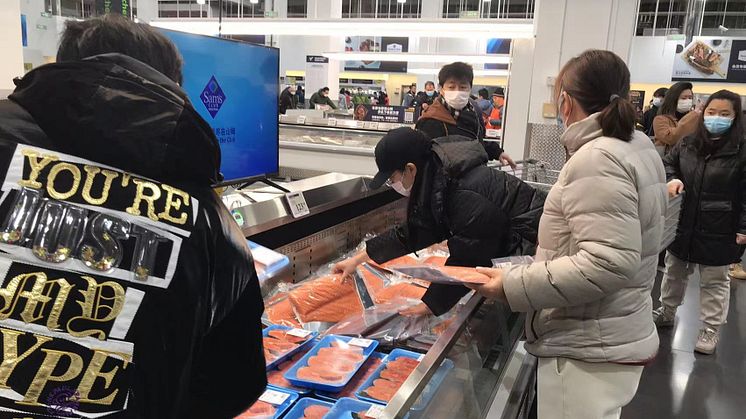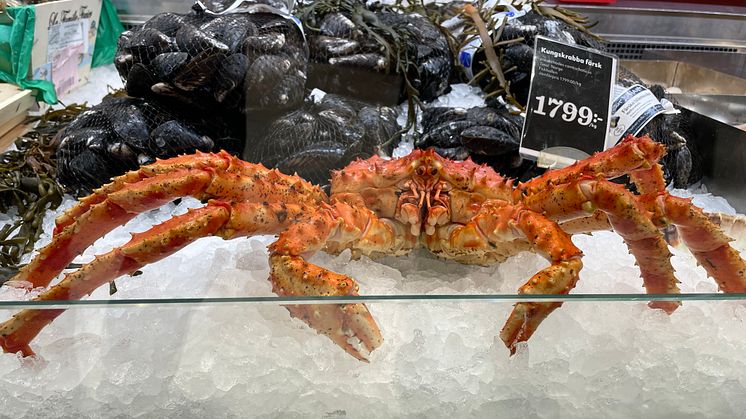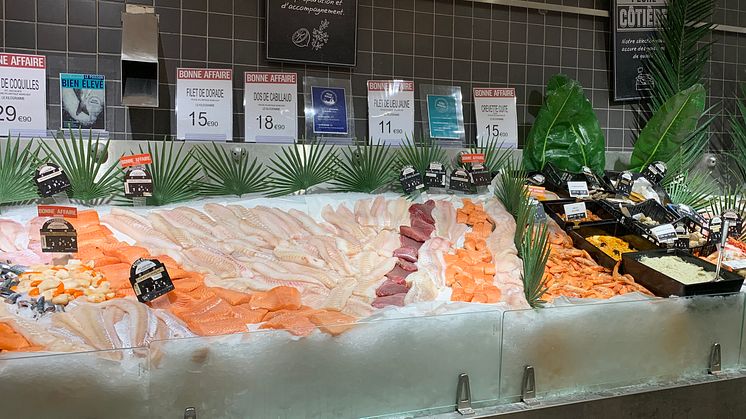
Press release -
Norwegian seafood exports totalled NOK 12.4 billion in July.
In July, Norway exported NOK 12.4 billion worth of seafood, an increase of NOK 928 million, or 8 per cent, compared to last year.
Year-on-year, seafood exports for the first seven months of this year have increased by NOK 13 billion, or 16 per cent, to reach a total value of NOK 94.4 billion.
"The increase in value this month is also primarily due to a weak Norwegian krone, although our currency strengthened somewhat in July", says Christian Chramer, Managing Director of the Norwegian Seafood Council.

"There has been a price increase for products such as fresh salmon fillets, cod clipfish and frozen whole mackerel, and this contributes to a very positive July. At the same time, we exported somewhat less cod, saithe and herring than last year", Chramer explains.
For several products, price growth measured in foreign currency has stopped. Measured in euros, the export price of fresh whole salmon is the same as 12 months ago, while the export price of fresh whole trout is as much as 28 per cent lower than in July last year.
- The largest markets for Norwegian seafood exports in July were Poland, Denmark, and the USA
- Although seafood was exported to 106 countries in July, this is six fewer than in July 2022.
Good demand for salmon
- Norway exported 95,620 tonnes of salmon to a value of NOK 9.6 billion in July.
- Export value increased by NOK 1.1 billion, or 13 per cent, compared to July last year.
- Export volume grew by 1 per cent.
- Poland, France, and Denmark were the biggest markets for salmon in July.
China had the most significant increase in value this month, with an increase in export value of NOK 230 million, or 90 per cent, compared to the same month last year. The export volume to China ended at 3,253 tonnes, 59 per cent higher than the same month last year.

"There has never been such a strong July for the export of salmon to China", says Andreas Thorud, the Seafood Council's representative in China.
"We must bear in mind that July 2022 was still characterized by Covid-19 and closures and that July is traditionally the high season for demand for salmon in the Chinese market".
Thorud says there is now a good demand for Norwegian salmon in China. The restaurant segment is well-established, but grocery and e-commerce are emerging as important sales channels.
"We also see an exciting tendency for more and more Norwegian salmon to be found in grocery stores even outside the big cities", he says.
A volume increase in trout exports
- Norway exported 5,845 tonnes of trout worth NOK 527 million in July
- The export value of trout increased by NOK 7 million, or 1 per cent, compared to July last year.
- There is a growth in volume of 14 per cent.
- The USA, Ukraine and Thailand were the biggest markets for trout in July.
Trout exports achieved a record high export value for a single month, NOK 3 million higher than the previous record month in June 2023.
Ukraine had the most significant increase in value this month, with an increase in export value of NOK 42 million, or 188 per cent, compared to the same month last year. The export volume to Ukraine ended at 890 tonnes, 178 per cent higher than the same month the previous year.
Fresh cod for European markets
- Norway exported 2,950 tonnes of fresh cod to a value of NOK 147 million in July
- Export value increased by NOK 23 million, or 18 per cent, compared to July last year.
- Export volume grew by 18 per cent.
- Denmark, Germany, and the Netherlands were the biggest markets for fresh cod in July.
While no farmed cod was exported in July 2022, 318 tonnes of fresh whole farmed cod were shipped to a value of NOK 20 million in July this year. Farmed cod, therefore, corresponds to 11 per cent of the export volume of fresh cod.
Frozen cod is doing well in the UK.
- Norway exported 3,289 tonnes of frozen cod worth NOK 206 million in July
- Export value fell by NOK 44 million, or 18 per cent, compared to July last year.
- Export volume fell by 27 per cent.
- Great Britain, Vietnam and China were the biggest markets for frozen cod in July.
Exports of frozen cod to the UK continue to increase. A total of 1,300 tonnes of frozen cod was exported to the UK in July, 6 per cent more than July last year, with growth for frozen whole and frozen cod fillets.
So far this year, 10,000 tonnes of frozen cod have been exported to the UK, and we must go back to 2002 to find a higher export volume of frozen cod to the UK after the first seven months of the year.
Rise in value for clipfish.
- Norway exported 4,839 tonnes of clipfish to a value of NOK 387 million in July
- Export value increased by NOK 31 million, or 9 per cent, compared to July last year.
- Export volume fell by 9 per cent.
- Portugal, Brazil, and the Dominican Republic were the biggest markets for clipfish in July.
For cod clipfish, the export volume ended at 2,100 tonnes, up 22 per cent, or 375 tonnes from the same month last year. The export value increased from NOK 74 million to NOK 254 million.
The export volume for clipfish of saithe ended at 2,500 tonnes, down 22 per cent, or 700 tonnes from the same month last year. The export value for clipfish from satithe finished at NOK 116 million, NOK 33 million lower than last year.
Portugal had the most significant increase in value this month, with an export value of NOK 80 million, or 57 per cent, compared to the same month last year. All exports to Portugal in July were cod clipfish.
Decrease in export value of salted fish.
- Norway exported 999 tonnes of salted fish to a value of NOK 73 million in July
- The value fell by NOK 5 million, or 6 per cent, compared to July last year.
- The volume fell by 16 per cent.
- Portugal, Italy and Canada were the biggest markets for salted fish in July
So far this year, 20,100 tonnes of salted fish have been exported, 9 per cent less than last year. However, the export value has increased by 12 per cent, from NOK 1.47 billion to NOK 1.65 billion.
A gain in export value for stockfish.
- Norway exported 109 tonnes of stockfish to a value of NOK 30 million in July
- Export value increased by NOK 7 million, or 31 per cent, compared to July last year.
- The volume fell by 16 per cent.
- Italy, the USA, and Nigeria were the biggest markets for stockfish in July.
Italy had the greatest increase in value this month, with an increase in export value of NOK 10 million, or 105 per cent, compared to the same month last year. The export volume to Italy ended at 62 tonnes, which is 55 per cent higher than the same month last year.
Low catches of herring.
- Norway exported 8,150 tonnes of herring worth NOK 153 million in July
- Export value fell by NOK 9 million, or 5 per cent, compared to July last year.
- Export volume fell by 34 per cent.
- The Netherlands, Poland and Lithuania were the biggest markets for herring in July.
The herring export in July is characterized by the fact that it has been a challenging North Sea herring fishery with significantly lower catches. So far this year, 56,000 tonnes have been landed, compared to 95,000 tonnes in the same period last year. There has not been so little herring exported in July since 1990.
The price level of herring products is well above the same period last year but has stagnated compared to previous months. At the same time, the prices of both North Sea herring and Norwegian spring-spawning herring are significantly higher at first hand.
- So far this year, the average price of North Sea herring from fishermen is NOK 8.90 per kg, compared to NOK 6.37 per kg last year, an increase of 40 per cent.
- For Norwegian spring-spawning herring, the average price from fishermen is NOK 7.89 per kg, compared to NOK 6.98 per kg last year, an increase of 13 per cent.
Low season for mackerel
- Norway exported 6,716 tonnes of mackerel to a value of NOK 151 million in July.
- Export value fell by NOK 1 million, or 1 per cent, compared to July last year.
- Export volume fell by 15 per cent.
- The Netherlands, Egypt and South Korea were the biggest markets for mackerel in July.
July is the low season for exporting mackerel from Norway, and July is the last month before mackerel from this year's mackerel season is sent out to the markets.
So far this year, the mackerel catches in Norway are on par with last year. 61,000 tonnes this year, against 62,500 tonnes in 2022.
The Prices for mackerel were also well above the same period last year, and for July, the average price was NOK 22.45 per kg, the highest average price achieved for Norwegian mackerel in a single month.
At the same time, the mackerel prices for fishermen are also higher than last year. So far this year, the average price here is NOK 15.33 per kg, while in the same period the previous year, it was NOK 14.53 per kg, an increase of 5.5 per cent.
Increased export volumes for king crab
- Norway exported 247 tonnes of king crab worth NOK 111 million in July
- The value increased by NOK 51 million, or 86 per cent, compared to July last year
- There is a growth in volume of 127 per cent
- Hong Kong SAR, the USA and South Korea were the biggest markets for king crab in July
The increase in the export of red king crab is driven by good fishing in July with increased landings, as well as the fact that, compared to last year, there is an increased export of live red king crab to Asia and the USA.
Exports of live king crab increased by 124 tonnes or 131 per cent. Regarding value, live king crab exports increased by 103 per cent, or NOK 49 million.
At the same time last year, there were significant challenges in exporting live red king crabs to Asia due to closed airspace over Russia. But the export figures for July this year show that exports are now at the level of the record year 2021.
"All Asian markets are increasing compared to July last year, but Hong Kong SAR had the most significant increase in value this month. There was an increase of NOK 27 million to NOK 35 million, or 326 per cent. The export volume ended at 87 tonnes, 296 per cent over July last year", says Josefine Voraa, Seafood Analyst with the Norwegian Seafood Council.
Decrease in exports of snow crab in July.
- Norway exported 111 tonnes of snow crab to a value of NOK 12 million in July
- Snow crab exports fell in value by NOK 20 million, or 63 per cent, compared to July last year.
- Export volume fell by 51 per cent.
- The USA, Canada and Indonesia were the biggest markets for snow crab in July.
The USA had the most significant increase in value this month, with an export value of NOK 9 million, compared to last year. The export volume to the USA ended at 80 tonnes.
Substantial drop in the volume of prawn exports
- Norway exported 902 tonnes of prawns worth NOK 70 million in July
- Export value fell by NOK 40 million, or 36 per cent, compared to July last year.
- Export volume fell by 62 per cent.
- Sweden, United Kingdom and Finland were the biggest markets for prawns in July
The fall in the value of prawns in July is due to a drop in exports of frozen industrial prawns to Iceland. Last year there were 1,143 tonnes of industrial prawns, compared to nothing in July this year.
Ukraine is now the 6th largest market for Norwegian prawns. There, the growth we have seen this year for frozen-cooked shell prawns continues, and the country had the most significant increase in value for prawns in July.
“In July this year, prawns were exported to Ukraine to a value of NOK 6.1 million, which is NOK 5 million, or 542 per cent, compared with the same month last year. The export volume ended at 101 tonnes, which is 494 per cent higher than the same month the previous year”, says Josefine Voraa.
Topics
Categories
The Norwegian Seafood Council works with the Norwegian fisheries and aquaculture industries to develop markets for Norwegian seafood through local market intelligence, market development and reputational risk management. The Seafood Council is headquartered in Tromsø and maintains local representatives in twelve of Norway's most important international markets. The Norwegian seafood industry finances the activities of the Norwegian Seafood Council via a tariff on all Norwegian seafood exports.
The Norwegian Seafood Council is a public company owned by the Ministry of Trade, Industry and Fisheries.






